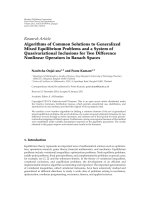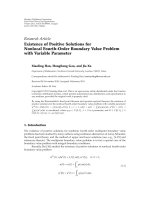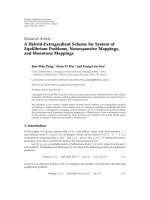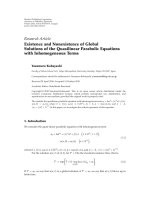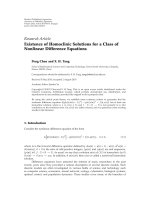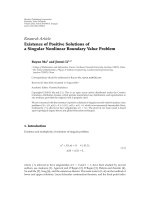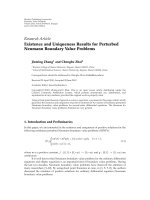Báo cáo hóa học: "Research Article Existence and Multiple Solutions for Nonlinear Second-Order Discrete Problems with Minimum and Maximum" ppt
Bạn đang xem bản rút gọn của tài liệu. Xem và tải ngay bản đầy đủ của tài liệu tại đây (529.83 KB, 16 trang )
Hindawi Publishing Corporation
Advances in Difference Equations
Volume 2008, Article ID 586020, 16 pages
doi:10.1155/2008/586020
Research Article
Existence and Multiple Solutions for
Nonlinear Second-Order Discrete Problems with
Minimum and Maximum
Ruyun Ma and Chenghua Gao
College of Mathematics and Information Science, Northwest Normal University, Lanzhou 730070, China
Correspondence should be addressed to Ruyun Ma,
Received 15 March 2008; Revised 6 June 2008; Accepted 19 July 2008
Recommended by Svatoslav Stan ˇek
Consider the multiplicity of solutions to the nonlinear second-order discrete problems with
minimum and maximum: Δ
2
uk−1fk,uk, Δuk, k ∈ T,min{uk : k ∈
T} A, max{uk :
k ∈
T} B,wheref : T × R
2
→R,a,b∈ N are fixed numbers satisfying b ≥ a 2, and A, B ∈ R are
satisfying B>A,
T {a 1, ,b− 1},
T {a, a 1, ,b− 1,b}.
Copyright q 2008 R. Ma and C. Gao. This is an open access article distributed under the Creative
Commons Attribution License, which permits unrestricted use, distribution, and reproduction in
any medium, provided the original work is properly cited.
1. Introduction
Let a, b ∈ N,a 2 ≤ b, T {a 1, ,b− 1},
T {a, a 1, ,b− 1,b}.Let
E :
u | u :
T −→ R
, 1.1
and for u ∈
E,let
u
E
max
k∈
T
uk
. 1.2
Let
E :
u | u : T −→ R
, 1.3
and for u ∈ E,let
u
E
max
k∈T
uk
. 1.4
It is clear that the above are norms on
E and E, respectively, and that the finite dimensionality
of these spaces makes them Banach spaces.
2 Advances in Difference Equations
In this paper, we discuss the nonlinear second-order discrete problems with minimum
and maximum:
Δ
2
uk − 1f
k, uk, Δuk
,k∈ T,
1.5
min
uk : k ∈
T
A, max
uk : k ∈
T
B,
1.6
where f : T × R
2
→ R is a continuous function, a, b ∈ N are fixed numbers satisfying b ≥ a 2
and A, B ∈ R satisfying B>A.
Functional boundary value problem has been studied by several authors 1–7.But
most of the papers studied the differential equations functional boundary value problem
1–6.Asweknow,thestudyofdifference equations represents a very important field in
mathematical research 8–12, so it is necessary to investigate the corresponding difference
equations with nonlinear boundary conditions.
Our ideas arise from 1, 3. In 1993, Brykalov 1 discussed the existence of two
different solutions to the nonlinear differential equation with nonlinear boundary conditions
x
h
t, x, x
,t∈ a, b,
min
ut : t ∈ a, b
A, max
ut : t ∈ a, b
B,
1.7
where h is a bounded function, that is, there exists a constant M>0, such that |ht, x, x
|≤
M. The proofs in 1 are based on the technique of monotone boundary conditions developed
in 2.From1, 2, it is clear that the results of 1 are valid for functional differential equations
in general form and for some cases of unbounded right-hand side of the equation see 1,
Remark 3 and 5, 2, Remark 2 and 8.
In 1998, Stan
ˇ
ek 3 worked on the existence of two different solutions to the nonlinear
differential equation with nonlinear boundary conditions
x
tFxt, a.e.t∈ 0, 1,
min
ut : t ∈ a, b
A, max
ut : t ∈ a, b
B,
1.8
where F satisfies the condition that there exists a nondecreasing function f : 0, ∞ → 0, ∞
satisfying
∞
0
ds/fs ≥ b − a,
∞
0
s/fsds ∞, such that
Fut
≤ f
u
t
. 1.9
It is not difficult to see that when we take Fut ht, u, u
, 1.8 is to be 1.7,andF may
not be bounded.
But as far as we know, there have been no discussions about the discrete problems
with minimum and maximum in literature. So, we use the Borsuk theorem 13 to discuss
the existence of two different solutions to the second-order difference equation boundary
value problem 1.5, 1.6 when f satisfies
H1 f : T × R
2
→ R is continuous, and there exist p : T → R,q: T → R,r: T → R, such
that
fk, u, v
≤ pk|u| qk|v| rk, k, u, v ∈ T × R
2
, 1.10
where Γ : 1 − b − a
b−1
ia1
|pi|−
b−1
ia1
|qi| > 0.
In our paper, we assume
l
sk
us0, if l<k.
R. Ma and C. Gao 3
2. Preliminaries
Definition 2.1. Let γ :
E → R be a functional. γ is increasing if
x, y ∈
E : xk <yk, for k ∈
T ⇒ γx <γy. 2.1
Set
A
γ | γ :
E −→ R is continuous and increasing
, A
0
γ | γ ∈A,γ00
. 2.2
Remark 2.2. Obviously, min{uk : k ∈
T}, max{uk : k ∈
T} belong to A
0
. Now, if we take
C B − A, ωumin
uk : k ∈
T
, 2.3
then boundary condition 1.6 is equal to
ωuA, max
uk : k ∈
T
− min
uk : k ∈
T
C. 2.4
So, in the rest part of this paper, we only deal with BVP 1.5, 2.4.
Lemma 2.3. Suppose c, d ∈ N,c<d,uuc,uc 1, ,ud.Ifthereexistη
1
,η
2
∈{c, c
1, ,d− 1,d},η
1
<η
2
, such that uη
1
uη
2
≤ 0,then
uk
≤ d − c max
k∈{c, ,η
2
−1}
Δuk
,k∈
c, ,η
1
,
uk
≤ d − c max
k∈{η
1
, ,η
2
−1}
Δuk
,k∈
η
1
1, ,η
2
,
uk
≤ d − c max
k∈{η
1
, ,d−1}
Δuk
,k∈
η
2
1, ,d
.
2.5
Furthermore, one has
max
k∈{c, ,d}
uk
≤ d − c max
k∈{c, ,d−1}
Δuk
. 2.6
Proof. Without loss of generality, we suppose uη
1
≤ 0 ≤ uη
2
.
i For k ≤ η
1
<η
2
, we have
uku
η
1
−
η
1
−1
ik
Δui,uku
η
2
−
η
2
−1
ik
Δui. 2.7
Then
−
η
2
−1
ik
Δui ≤ uk ≤−
η
1
−1
ik
Δui. 2.8
Furthermore,
uk
≤ max
η
2
−1
ik
Δui
,
η
1
−1
ik
Δui
, 2.9
which implies
uk
≤ d − c max
k∈{c, ,η
2
−1}
Δuk
. 2.10
4 Advances in Difference Equations
ii For η
1
<k≤ η
2
,weget
uku
η
1
k−1
iη
1
Δui,uku
η
2
−
η
2
−1
ik
Δui. 2.11
Then
−
η
2
−1
ik
Δui ≤ uk ≤
k−1
iη
1
Δui. 2.12
Furthermore,
uk
≤ max
η
2
−1
ik
Δui
,
k−1
iη
1
Δui
, 2.13
which implies
uk
≤ d − c max
k∈{η
1
, ,η
2
−1}
Δuk
. 2.14
iii For η
1
<η
2
<k, we have
uku
η
1
k−1
iη
1
Δui,uku
η
2
k−1
iη
2
Δui. 2.15
Then
k−1
iη
2
Δui ≤ uk ≤
k−1
iη
1
Δui. 2.16
Furthermore,
uk
≤ max
k−1
iη
2
Δui
,
k−1
iη
1
Δui
, 2.17
which implies
uk
≤ d − c max
k∈{η
1
, ,d−1}
Δuk
. 2.18
In particular, it is not hard to obtain
max
k∈{c, ,d}
uk
≤ d − c max
k∈{c, ,d−1}
Δuk
. 2.19
Similarly, we can obtain the following lemma.
R. Ma and C. Gao 5
Lemma 2.4. Suppose c, d ∈ N,c<d,uuc,uc 1, ,ud.Ifthereexistsη
1
∈{c, c
1, ,d− 1,d} such that uη
1
0,then
uk
≤ d − c max
k∈{c, ,η
1
−1}
Δuk
,k∈
c, ,η
1
,
uk
≤ d − c max
k∈{η
1
, ,d−1}
Δuk
,k∈
η
1
1, ,d
.
2.20
In particular, one has
max
k∈{c, ,d}
uk
≤ d − c max
k∈{c, ,d−1}
Δuk
. 2.21
Lemma 2.5. Suppose γ ∈A
0
,c∈ 0, 1.Ifu ∈
E satisfies
γu − cγ−u0, 2.22
then there exist ξ
0
,ξ
1
∈
T, such that uξ
0
≤ 0 ≤ uξ
1
.
Proof. We only prove that there exists ξ
0
∈
T, such that uξ
0
≤ 0, and the other can be proved
similarly.
Suppose uk > 0fork ∈
T. Then γu >γ00,γ−u <γ00. Furthermore,
γu − cγ−u > 0, which contradicts with γu − cγ−u0.
Define functional φ : va,va 1, ,vb − 1 → R by
φvmax
d−1
kc
vk : c ≤ d, c, d ∈
T \{b}
. 2.23
Lemma 2.6. Suppose uk is a solution of 1.5 and ωu0.Then
min
φΔu,φ−Δu
≤
b − a
2Γ
b−1
ia1
ri
. 2.24
Proof. Let
C
k | Δuk > 0,k∈
T \{b}
,C
−
k | Δuk < 0,k∈
T \{b}
, 2.25
and N
C
be the number of elements in C
,N
C
−
the number of elements in C
−
.
If C
∅, then φΔu0; if C
−
∅, then φ−Δu0. Equation 2.24 is obvious.
Now, suppose C
/
∅ and C
−
/
∅.Itiseasytoseethat
min
N
C
,N
C
−
≤
b − a
2
. 2.26
At first, we prove the inequality
φΔu ≤
N
C
Γ
b−1
ia1
ri
. 2.27
Since ωu0, by Lemma 2.5 , there exist ξ
1
,ξ
2
∈
T,ξ
1
≤ ξ
2
, such that uξ
1
uξ
2
≤ 0.
Without loss of generality, we suppose uξ
1
≤ 0 ≤ uξ
2
.
6 Advances in Difference Equations
For any α ∈ C
, there exits β satisfying one of the following cases:
Case 1. β min{k ∈
T \{b}|Δuk ≤ 0,k > α},
Case 2. β max{k ∈
T \{b}|Δuk ≤ 0,k < α}.
We only prove that 2.27 holds when Case 1 occurs, if Case 2 occurs, it can be
similarly proved.
If Case 1 holds, we divide the proof into two cases.
Case 1.1. If uαuβ ≤ 0, without loss of generality, we suppose uα ≤ 0 ≤ uβ, then by
Lemma 2.3, we have
uk
≤ b
− a max
k∈{α, ,β−1}
Δuk
,k∈{α 1, ,β}. 2.28
Combining this with
0 ≥ uαuβ −
β−1
iα
Δui ≥−
β−1
iα
Δui, 2.29
we have
uk
≤ b − a max
k∈{α, ,β−1}
Δuk
,k∈{α, ,β}. 2.30
At the same time, for k ∈{α, ,β− 1}, we have Δuk > 0and
ΔukΔuβ −
β
ik1
Δ
2
ui − 1, ΔukΔuα
k
iα1
Δ
2
ui − 1. 2.31
For k β,weget
0 ≥ ΔuβΔuα
β
iα1
Δ
2
ui − 1 ≥
β
iα1
Δ
2
ui − 1. 2.32
So, for k ∈{α, ,β},
Δuk
≤ max
k
iα1
Δ
2
ui − 1
,
β
ik1
Δ
2
ui − 1
≤
β
iα1
Δ
2
ui − 1
β
iα1
f
i, ui, Δui
≤
β
iα1
pi
ui
qi
Δui
ri
≤
b−1
ia1
pi
b − a max
k∈{α, ,β−1}
Δuk
qi
max
k∈{α, ,β}
Δuk
ri
.
2.33
Thus
Δuα
≤ max
k∈{α, ,β}
Δuk
≤
1
Γ
b−1
ia1
ri
. 2.34
R. Ma and C. Gao 7
Case 1.2 uαuβ ≥ 0. Without loss of generality, we suppose uα ≥ 0,uβ ≥ 0. Then ξ
1
will be discussed in different situations.
Case 1.2.1 ξ
1
<α≤ β.ByLemma 2.3 we take η
1
ξ
1
,η
2
α, d β,itisnotdifficult to see
that
uk
≤ b − a max
k∈{ξ
1
, ,β−1}
Δuk
,k∈
ξ
1
1, ,β
. 2.35
For k ξ
1
, we have
0 ≥ u
ξ
1
uα −
α−1
iξ
1
Δui ≥−
α−1
iξ
1
Δui. 2.36
So, we get
uk
≤ b − a max
k∈{ξ
1
, ,β−1}
Δuk
,k∈
ξ
1
, ,β
. 2.37
At the same time, for k ∈{α, ,β},
ΔukΔuβ −
β
ik1
Δ
2
ui − 1, ΔukΔuα
k
iα1
Δ
2
ui − 1. 2.38
Combining this with Δuβ ≤ 0, Δuα > 0, we have
Δuk
≤ max
β
ik1
Δ
2
ui − 1
,
k
iα1
Δ
2
ui − 1
≤
β
iα1
Δ
2
ui − 1
≤
β
iα1
pi
ui
qi
Δui
ri
≤
b−1
ia1
pi
b − a max
k∈{ξ
1
, ,β−1}
Δuk
qi
max
k∈{α1, ,β}
Δuk
ri
,
2.39
for k ∈{α, ,β}.
Also, for k ∈{ξ
1
, ,α− 1}, we have Δuk > 0and
ΔukΔuβ −
β
ik1
Δ
2
ui − 1, ΔukΔuα −
α
ik1
Δ
2
ui − 1. 2.40
Similarly, we get
Δuk
≤
b−1
ia1
pi
b − a max
k∈{ξ
1
, ,β−1}
Δuk
qi
max
k∈{ξ
1
1, ,β}
Δuk
ri
. 2.41
8 Advances in Difference Equations
By 2.39 and 2.41,fork ∈{ξ
1
, ,β},
Δuk
≤
b−1
ia1
pi
b − a max
k∈{ξ
1
, ,β}
Δuk
qi
max
k∈{ξ
1
, ,β}
Δuk
ri
. 2.42
Then
Δuα
≤ max
k∈{ξ
1
, ,β}
Δuk
≤
1
Γ
b−1
ia1
ri
. 2.43
Case 1.2.2 α ≤ ξ
1
<β.ByLemma 2.3 we take c α, η
1
ξ
1
,η
2
β, it is easy to obtain that
uk
≤ b − a max
k∈{α, ,β−1}
Δuk
,k∈{α, ,β}. 2.44
At the same time, for k ∈{α, ,β},
ΔukΔuβ −
β
ik1
Δ
2
ui − 1, ΔukΔuα
k
iα1
Δ
2
ui − 1.
2.45
Together with Δuβ ≤ 0, Δuα > 0, we have
Δuk
≤ max
β
ik1
Δ
2
ui − 1
,
k
iα1
Δ
2
ui − 1
≤
β
iα1
Δ
2
ui − 1
≤
β
iα1
pi
ui
qi
Δui
ri
≤
b−1
ia1
pi
b − a max
k∈{α, ,β−1}
Δuk
qi
max
k∈{α, ,β}
Δuk
ri
.
2.46
Thus
Δuα
≤ max
k∈{α, ,β}
Δuk
≤
1
Γ
b−1
ia1
ri
. 2.47
Case 1.2.3 α<β≤ ξ
1
. Without loss of generality, we suppose β<ξ
1
when β ξ
1
,by
Lemma 2.4, it can be proved similarly. Then from Lemma 2.3 we take c α, η
1
β, η
2
ξ
1
,itisnotdifficult to see that
uk
≤ b − a max
k∈{α, ,ξ
1
−1}
Δuk
,k∈
α, ,ξ
1
. 2.48
For k ∈{α, ,β− 1}, we have
ΔukΔuβ −
β
ik1
Δ
2
ui − 1. 2.49
R. Ma and C. Gao 9
Together with Δuβ ≤ 0andΔuk > 0, for k ∈{α, ,β− 1},weget
Δuk
≤
β
ik1
Δ
2
ui − 1
β
ik1
f
i, ui, Δui
≤
β
ik1
pi
ui
qi
Δui
ri
≤
β
ik1
pi
b − a max
k∈{α, ,ξ
1
−1}
Δuk
qi
max
k∈{α, ,ξ
1
−1}
Δuk
ri
,
2.50
for k ∈{α, ,β− 1}.
Also, for k ∈{β, ,ξ
1
}, we have
ΔukΔuα
k
iα1
Δ
2
ui − 1, ΔukΔuβ
k
iβ1
Δ
2
ui − 1. 2.51
This being combined with Δuβ ≤ 0, Δuα > 0, we get
Δuk
≤ max
k
iα1
Δ
2
ui − 1
,
k
iβ1
Δ
2
ui − 1
≤
ξ
1
iα1
Δ
2
ui − 1
≤
ξ
1
iα1
pi
max
k∈{α, ,ξ
1
−1}
Δuk
qi
max
k∈{α, ,ξ
1
}
Δuk
ri
.
2.52
From 2.50 and 2.52,
Δuα
≤ max
k∈{α, ,ξ
1
}
Δuk
≤
1
Γ
b−1
ia1
ri
. 2.53
At last, from Case 1 and Case 2,weobtain
Δuk ≤
1
Γ
b−1
ia1
ri
,k∈ C
. 2.54
Then by the definition of φ and 2.54,
φΔu ≤
k∈C
Δuk ≤
b−1
ia1
ri
Γ
k∈C
≤
N
C
Γ
b−1
ia1
ri
. 2.55
10 Advances in Difference Equations
Similarly, we can prove
φ−Δu ≤
N
C
−
Γ
b−1
ia1
ri
. 2.56
From 2.26, 2.55,and2.56, the assertion is proved.
Remark 2.7. It is easy to see that φ is continuous, and
max
uk : k ∈
T
− min
uk : k ∈
T
max
φΔu,φ−Δu
. 2.57
Lemma 2.8. Let C be a positive constant as in 2.3, ω as in 2.3, φ as in 2.23.Set
Ω
u, α, β | u, α, β ∈
E × R
2
, u
E
< C 1b − a,
|α| < C 1b − a, |β| <C 1
.
2.58
Define Γ
i
: Ω →
E × R
2
i 1, 2:
Γ
1
u, α, β
α βk − a,α ωu,β φΔu − C
,
Γ
2
u, α, β
α βk − a,α ωu,β φ−Δu − C
.
2.59
Then
DI − Γ
i
, Ω, 0
/
0,i 1, 2, 2.60
where D denotes Brouwer degree, and I the identity operator on
E × R
2
.
Proof. Obviously, Ω is a bounded open and symmetric with respect to θ ∈ Ω subset of Banach
space
E × R
2
.
Define H, G : 0, 1 ×
Ω →
E × R
2
Hλ, u, α, β
α βk − a,α ωu − 1 − λω−u,β φΔu
− φλ − 1Δu − λC
,
Gλ, u, α,βu, α, β − Hλ, u, α,β.
2.61
For u, α, β ∈
Ω,
G1,u,α,βu, α, β −
α βk − a,α ωu,β φΔu − C
I − Γ
1
u, α, β.
2.62
By Borsuk theorem, to prove DI − Γ
1
, Ω, 0
/
0, we only need to prove that the following
hypothesis holds.
a G0, ·, ·, · is an odd operator on
Ω,thatis,
G0, −u, −α, −β−G0,u,α,β, u, α, β ∈
Ω; 2.63
R. Ma and C. Gao 11
b H is a completely continuous operator;
c Gλ, u, α, β
/
0forλ, u,α, β ∈ 0, 1 × ∂Ω.
First, we take u, α, β ∈
Ω, then
G0, −u, −α, −β
−u, −α, −β −
− α − βk − a, −α ω−u − ωu, −β φ−Δu − φΔu
−
u, α, β − α βk − a,α ωu − ω−u,β φΔu − φ−Δu
−G0,u,α,β.
2.64
Thus a is asserted.
Second, we prove b.
Let λ
n
,u
n
,α
n
,β
n
⊂ 0, 1 × Ω be a sequence. Then for each n ∈ Z
and the fact k ∈
T, |λ
n
|≤1, |α
n
|≤C 1b − a, |β
n
|≤C 1, u
E
≤ C 1b − a. The Bolzano-Weiestrass
theorem and
E is finite dimensional show that, going if necessary to subsequences, we can
assume lim
n→∞
λ
n
λ
0
, lim
n→∞
α
n
α
0
, lim
n→∞
β
n
β
0
, lim
n→∞
u
n
u. Then
lim
n→∞
H
λ
n
,u
n
,α
n
,β
n
lim
n→∞
α
n
β
n
k − a,λ
n
ω
u
n
−
1 − λ
n
ω
− u
n
,
β
n
φ
Δu
n
− φ
λ
n
− 1
Δu
n
− λ
n
C
α
0
β
0
k − a,λ
0
ωu −
1 − λ
0
ω−u,
β
0
φΔu − φ
λ
0
− 1
Δu
− λ
0
C.
2.65
Since ω and φ are continuous, H is a continuous operator. Then H is a completely continuous
operator.
At last, we prove c.
Assume, on the contrary, that
H
λ
0
,u
0
,α
0
,β
0
u
0
,α
0
,β
0
, 2.66
for some λ
0
,u
0
,α
0
,β
0
∈ 0, 1 × ∂Ω. Then
α
0
β
0
k − au
0
k,k∈
T,
2.67
ω
u
0
−
1 − λ
0
ω
− u
0
0, 2.68
φ
Δu
0
− φ
λ
0
− 1
Δu
0
λ
0
C. 2.69
By 2.67 and Lemma 2.5 take u u
0
,c 1 − λ
0
, there exists ξ ∈
T, such that u
0
ξ ≤ 0. Also
from 2.67, we have u
0
ξα
0
β
0
ξ − a, then we get
u
0
ku
0
ξβ
0
k − ξ, 2.70
u
0
k ≤ β
0
k − ξ,k∈
T.
2.71
12 Advances in Difference Equations
Case 1. If β
0
0, then u
0
k ≤ 0. Now, we claim u
0
k ≡ 0,k∈
T. In fact, u
0
k ≤ 0and2.68
show that there exists k
0
∈
T satisfying u
0
k
0
0. This being combined with Δu
0
kβ
0
0,
u
0
k ≡ 0,k∈
T. 2.72
So, α
0
u
0
a0, which contradicts with u
0
,α
0
,β
0
∈ ∂Ω.
Case 2. If β
0
> 0, then from 2.67, Δu
0
k > 0, and the definition of φ, we have
φ
Δu
0
− φ
λ
0
− 1
Δu
0
β
0
b − a. 2.73
Together with 2.69,wegetφβ
0
λ
0
C,and
β
0
λ
0
C
b − a
<C 1. 2.74
Furthermore, Δu
0
k > 0 shows that u
0
k is strictly increasing. From 2.68 and
Lemma 2.5, there exist ξ
0
,ξ
1
∈
T satisfying u
0
ξ
0
≤ 0 ≤ u
0
ξ
1
.Thus,u
0
a ≤ 0 ≤ u
0
b.It
is not difficult to see that
u
0
au
0
ξ
1
−
ξ
1
−1
ka
Δu
0
k ≥−
ξ
1
−1
ka
Δu
0
k, 2.75
that is,
u
0
a
≤
−
ξ
1
−1
ka
Δu
0
k
< C 1b − a. 2.76
Similarly, |u
0
b| < C 1b −a, then we get u
0
E
< C 1b −a and |α
0
| |u
0
a| <
C 1b − a, which contradicts with u
0
,α
0
,β
0
∈ ∂Ω.
Case 3. If β
0
< 0, then from 2.67,wegetΔu
0
kβ
0
< 0and
φ
Δu
0
− φ
λ
0
− 1
Δu
0
1 − λ
0
β
0
b − a. 2.77
By 2.69, we have
1 − λ
0
β
0
b − aλ
0
C. 2.78
If λ
0
0, then β
0
b − a0. Furthermore, β
0
0, which contradicts with β
0
< 0.
If λ
0
1, then λ
0
C 0. Furthermore, C 0, which contradicts with C>0.
If λ ∈ 0, 1, then 1 − λ
0
β
0
b − a < 0,λ
0
C>0, a contradiction.
Then c is proved.
From the above discussion, the conditions of Borsuk theorem are satisfied. Then, we
get
DI − Γ
1
, Ω, 0
/
0. 2.79
Set
Hλ, u, α, β
α βk − a,α ωu − 1 − λω−u,
β φ−Δu − φ
1 − λΔu
− λC
.
2.80
Similarly, we can prove
DI − Γ
2
, Ω, 0
/
0. 2.81
R. Ma and C. Gao 13
3. The main results
Theorem 3.1. Suppose H1 holds. Then 1.5 and 1.6 have at least two different solutions when
A 0 and
C>
b − a
2Γ
b−1
ia1
ri
. 3.1
Proof. Let A 0,C>b − a/2Γ
b−1
ia1
|ri|. Consider the boundary conditions
ωu0,φΔuC, 3.2
ωu0,φ−ΔuC. 3.3
Suppose uk is a solution of 1.5. Then from Remark 2.7,
max
uk : k ∈
T
− min
uk : k ∈
T
max
φΔu,φ−Δu}. 3.4
Now, if 1.5 and 3.2 have a solution u
1
k, then Lemma 2.6 and 3.2 show that φ−Δu
1
<
C and
max
u
1
k : k ∈
T
− min
u
1
k : k ∈
T
C. 3.5
So, u
1
k is a solution of 1.5 and 2.4,thatis,u
1
k is a solution of 1.5 and 1.6.
Similarly, if 1.5, 3.3 have a solution u
2
k, then φΔu
2
<Cand
max
u
2
k : k ∈
T
− min
u
2
k : k ∈
T
C. 3.6
So, u
2
k is a solution of 1.5 and 2.4.
Furthermore, since φΔu
1
C and φΔu
2
<C, u
1
/
u
2
.
Next, we need to prove BVPs 1.5, 3.2,and1.5 and 3.3 have solutions,
respectively.
Set
Ω
u, α, β|u, α, β ∈
E × R
2
, u
E
< C 1b − a,
|α| < C 1b − a, |β| <C 1
.
3.7
Define operator S
1
: 0, 1 × Ω →
E × R
2
,
S
1
λ, u, α,β
α βk − aλ
k−1
ia
i
la1
f
l, ul, Δul
,α ωu,β φΔu − C
. 3.8
Obviously,
S
1
0,u,α,βΓ
1
u, α, β, u, α, β ∈ Ω. 3.9
Consider the parameter equation
S
1
λ, u, α,βu, α, β,λ∈ 0, 1. 3.10
Now, we prove 3.10 has a solution, when λ 1.
14 Advances in Difference Equations
By Lemma 2.8, DI − Γ
1
, Ω, 0
/
0. Now we prove the following hypothesis.
a S
1
λ, u, α,β is a completely continuous operator;
b
S
1
λ, u, α,β
/
u, α, β, λ, u, α, β ∈ 0, 1 × ∂Ω. 3.11
Since
E is finite dimensional, S
1
λ, u, α,β is a completely continuous operator.
Suppose b is not true. Then,
S
1
λ
0
,u
0
,α
0
,β
0
u
0
,α
0
,β
0
, 3.12
for some λ
0
,u
0
,α
0
,β
0
∈ 0, 1 × ∂Ω. Then
u
0
kα
0
β
0
k − aλ
0
k−1
ia
i
la1
f
l, ul, Δul
,
3.13
ω
u
0
0,
3.14
φ
Δu
0
C. 3.15
From 3.13, u
0
k is a solution of second-order difference equation Δ
2
uk − 1
λ
0
fk,uk, Δuk.ByRemark 2.7, max
k∈
T\{b}
|Δu
0
k|≤C<C 1. And from 3.14, there
exist ξ
0
,ξ
1
∈
T, such that u
0
ξ
0
≤ 0 ≤ u
0
ξ
1
. Now, we can prove it in two cases.
Case 1. If there exists ξ ∈
T, such that u
0
ξ0, then
i for all k ∈{k, ,ξ},
u
0
k
u
0
ξ −
ξ−1
ik
Δu
0
i
≤
ξ−1
ik
Δu
0
i
< C 1b − a. 3.16
ii For all k ∈{ξ 1, ,b},
u
0
k
u
0
ξ
k−1
iξ
Δu
0
i
≤
k−1
iξ
Δu
0
i
< C 1b − a. 3.17
Case 2. If ∀k ∈
T, u
0
k
/
0. Set
C
k | u
0
k > 0,k∈
T
,C
−
k | u
0
k < 0,k∈
T
,
k
0
max C
,k
1
min C
−
.
3.18
i For k ∈ C
,ifk<k
1
, then
u
0
ku
0
k
1
−
k
1
−1
ik
Δu
0
i < −
k
1
−1
ik
Δu
0
i, 3.19
that is,
u
0
k
<
k
1
−1
ik
Δu
0
i
< C 1b − a. 3.20
R. Ma and C. Gao 15
For k>k
1
,
u
0
ku
0
k
1
k−1
ik
1
Δu
0
i <
k−1
ik
1
Δu
0
i, 3.21
then
u
0
k
< C 1b − a. 3.22
ii Similarly, we can prove |u
0
k| < C 1b − a for k ∈ C
−
.
Combining Case 1 with Case 2,weget
u
0
k
< C 1b − a,k∈
T. 3.23
Moreover, α
0
u
0
a,β
0
Δu
0
a,so,
α
0
≤
u
0
E
< C 1b − a,
β
0
<C 1, 3.24
which contradicts with u
0
,α
0
,β
0
∈ ∂Ω.
Similarly, consider the operator S
2
: 0, 1 × Ω →
E × R
2
,
S
2
λ, u, α,β
α βk − a
k−1
ia
i
la1
f
l, ul, Δul
,α ωu,β φ−Δu − C
, 3.25
we can obtain a solution of BVP 1.5 and 3.3.
Theorem 3.2. Suppose H1 holds. Then 1.5 and 1.6 have at least two different solutions when
A, B ∈ R and
C>
b − a
2Γ
b−1
ia1
ri
. 3.26
Proof. Obviously, ωAA.Set
ωuωu A − A. 3.27
Then ω00. Define continuous function f
1
: T × R
2
→ R,
f
1
k, uk, Δuk
f
k, vk, Δvk
,vkukA. 3.28
Then
f
1
k, uk, Δuk
f
k, vk, Δvk
≤ pk
vk
qk
Δvk
rk
≤ pk
uk
qk
Δuk
rkpkA.
3.29
Set rkrkpkA. Then f
1
satisfies H1.
By Theorem 3.1,
Δ
2
uk − 1f
1
k, uk, Δuk
,k∈ T,
3.30
ωu0, max
uk : k ∈
T
− min
uk : k ∈
T
B − A : C
3.31
have at least two difference solutions u
1
k,u
2
k. Since uk is a solution of 3.30,ifand
only if ukA is a solution of 1.5,weseethat
u
i
ku
i
kA, i 1, 2 3.32
are two different solutions of 1.5 and 2.4, then u
i
k are the two different solutions of 1.5
and 1.6.
16 Advances in Difference Equations
Acknowledgments
This work was supported by the NSFC Grant no. 10671158, the NSF of Gansu Province
Grant no. 3ZS051-A25-016, NWNU-KJCXGC, the Spring-sun Program no. Z2004-1-62033,
SRFDPGrant no. 20060736001, and the SRF for ROCS, SEM 2006311.
References
1 S. A. Brykalov, “Solutions with a prescribed minimum and maximum,” Differencial’nye Uravnenija,
vol. 29, no. 6, pp. 938–942, 1993 Russian, translation in Differential Equations, vol. 29, no. 6, pp. 802–
805, 1993.
2 S. A. Brykalov, “Solvability of problems with monotone boundary conditions,” Differencial’nye
Uravnenija, vol. 29, no. 5, pp. 744–750, 1993 Russian , translation in Differential Equations, vol. 29,
no. 5, pp. 633–639, 1993.
3 S. Stan
ˇ
ek, “Multiplicity results for second order nonlinear problems with maximum and minimum,”
Mathematische Nachrichten, vol. 192, no. 1, pp. 225–237, 1998.
4 S. Stan
ˇ
ek, “Multiplicity results for functional boundary value problems,” Nonlinear Analysis: Theory,
Methods & Applications, vol. 30, no. 5, pp. 2617–2628, 1997.
5 W. M. Whyburn, “Differential equations with g eneral boundary conditions,” Bulletin of the American
Mathematical Society, vol. 48, pp. 692–704, 1942.
6 R. Ma and N. Castaneda, “Existence of solutions of boundary value problems for second order
functional differential equations,” Journal of Mathematical Analysis and Applications, vol. 292, no. 1,
pp. 49–59, 2004.
7 A. Cabada, “Extremal solutions for the difference ϕ-Laplacian problem with nonlinear functional
boundary conditions,” Computers & Mathematics with Applications, vol. 42, no. 3–5, pp. 593–601, 2001.
8 R. Ma, “Nonlinear discrete Sturm-Liouville problems at resonance,” Nonlinear Analysis: Theory,
Methods & Applications, vol. 67, no. 11, pp. 3050–3057, 2007.
9 R. Ma, “Bifurcation from infinity and multiple solutions for some discrete Sturm-Liouville problems,”
Computers & Mathematics with Applications, vol. 54, no. 4, pp. 535–543, 2007.
10 R. Ma, H. Luo, and C. Gao, “On nonresonance problems of second-order di ff
erence systems,”
Advances in Difference Equations, vol. 2008, Article ID 469815, 11 pages, 2008.
11 J P. Sun, “Positive solution for first-order discrete periodic boundary value problem,” Applied
Mathematics Letters, vol. 19, no. 11, pp. 1244–1248, 2006.
12 C. Gao, “Existence of solutions to p-Laplacian difference equations under barrier strips conditions,”
Electronic Journal of Differential Equations, vol. 2007, no. 59, pp. 1–6, 2007.
13 K. Deimling, Nonlinear Functional Analysis, Springer, Berlin, Germany, 1985.


